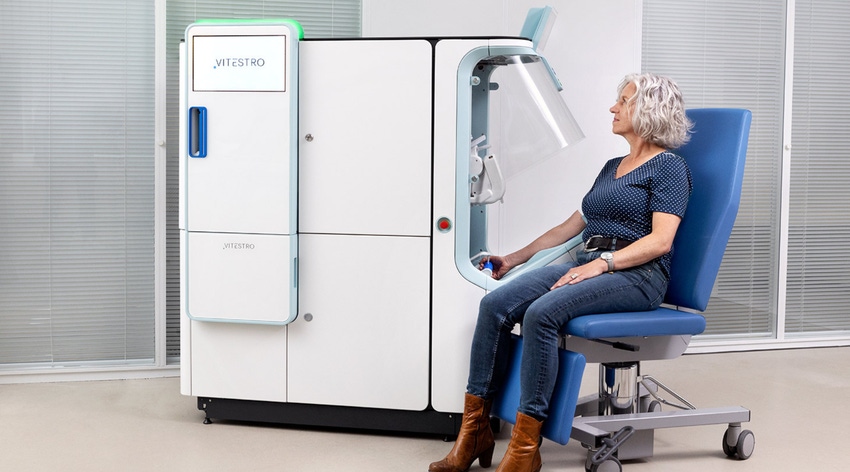Win, Lose or Draw – Has Robotic Phlebotomy Finally Arrived?
A Netherlands startup is trying to automate the process of drawing blood.
November 20, 2023

While many other areas in the practice of medicine have been augmented by increasingly sophisticated technology, phlebotomy – the practice of drawing blood for laboratory analysis – has remained stubbornly manual, relying on a phlebotomist’s poke of a patient’s arm to find a suitable vein.
Alas, in patients with hard-to-find veins, whether through medical condition or just an anatomy that makes finding a vein hard, drawing blood can become a process that takes more than one stick and creates pain and frustration. In cases where patients have difficult veins to access, researchers have found failure rates of 27% for patients without visible veins, 40% for patients without palpable veins, and 60% for patients who were emaciated.
Viestro, a Utrecht, Netherlands-based developer of an automated blood-drawing process, is trying to change that model. The company recently announced the first 350 patients of an estimated 13,000 have been enrolled in a trial of the company’s autonomous blood drawing device. The company says the ADOPT (Autonomous Blood Drawing Optimization and Performance Testing) trial is the most significant study worldwide to date of autonomous blood collection, and expects to obtain a European CE mark by the end of 2024.
Not a first mover
Vitestro is not the first company to tackle the vagaries of phlebotomy. A company called Veebot was receiving attention in technology media outlets in 2013 for its autonomous device; in addition, researchers at Rutgers University also developed a robotic phlebotomy platform in 2020. However, no further progress on either has been reported. Veebot did not respond to requests for comment, and a Rutgers representative said no one connected with the research there was available to speak.
However, leading testing labs are certainly watching the space closely.
“We are aware of Vitestro and other companies’ efforts to evolve the phlebotomy process through the use of robotics and further emerging technologies like AI,” Alexander Louis, vice president for corporate enterprise operations at Quest Diagnostics, told MD+DI. “The process by which a phlebotomist finds a patient’s vein and manually draws blood has gone unchanged for a long time. The concept of a blood-drawing robot would be a big change and is complex – it would require research on our end before widespread adoption.”
The technology principles behind robotic venipuncture are fairly consistent. Typically, the machines use a combination of machine learning, such as computer vision, with ultrasound, to find likely veins; the robotic drawing assembly, which usually includes some sort of arm rest, cuff or tourniquet, and needle assembly, then performs the draw. But combining all these actions into one smooth procedure has presented challenges, such as devising a robot mechanism with sufficient degrees of freedom to adapt to anatomical variability among patients or subtle movements of arms and tissues during the procedure.
Luuk Giesen, MD, Vitestro’s chief medical officer, said the company is aware of preceding attempts to market autonomous blood drawing technology going back to the 1990s, and is prepared to rigorously run its machine through the trial process, which he said will iteratively test updated versions of the device, to make sure it works up to accepted clinical standards.
“A device needs to be able to draw blood from the majority of the population for it to be beneficial for clinical practice,” Giesen told MD+DI. “There is so much variation in arms, veins, patient behavior, etcetera, that this is not trivial.”
“Moreover, the blood samples need to have a sufficient quality,” he said. “Also, you need a design which is inviting to patients and intuitive to use. You need to think of infection control. You need to ensure no use errors can occur which lead to harm for patients or professional. Last, the device needs to be efficient and technologically robust because it is deployed in a high-volume blood draw department.”
Giesen also said the company appears to have timed its attempt at introducing the machine well, given the projected shortage of qualified medical professionals; one phlebotomist might be able to manage two to four devices and be ready to assist patients on those machines simultaneously, though in principle, it is intended to be a medically supervised self-service experience.
“There is a clear need in the market because the staffing shortages have never been more pressing. Therefore, laboratories and hospitals need to invest in new solutions,” Giesen said.
Recent funding Vitestro has received might indicate the company’s technology may indeed be ready to enter the market on its stated timetable. The company secured a €12 million investment from San Carlos, CA-based Sonder Capital and installed Sonder managing partner Fred Moll, MD, co-founder of robotic surgery pioneer Intuitive Surgical, as a non-executive member of its board. The company has also announced one of its partners in the ADOPT trial, OLVG Lab, plans to install “multiple” machines once the product has a CE mark. Giesen said the company hopes to receive FDA de novo approval sometime in 2025.
Quest’s Louis said the organization is certainly open to considering autonomous blood drawing technology, but also cautioned widespread adoption will take a while.
“With a range of criteria involved in evaluating any technology, something like FDA approval is just one piece of the picture,” he said. “Ultimately, the complete picture we look at includes things like a technology’s ability to improve the patient or employee experience, as well as improvements in quality or efficiency.”
“We see opportunities to leverage automation and artificial intelligence along our entire value chain. While our use of automation and AI began in key processes within our labs, we're starting to progress these technologies into back-end areas, including for some administrative and customer service functions. Areas that interact with patients directly are farther away, given the complexity of human engagement.”
About the Author(s)
You May Also Like



